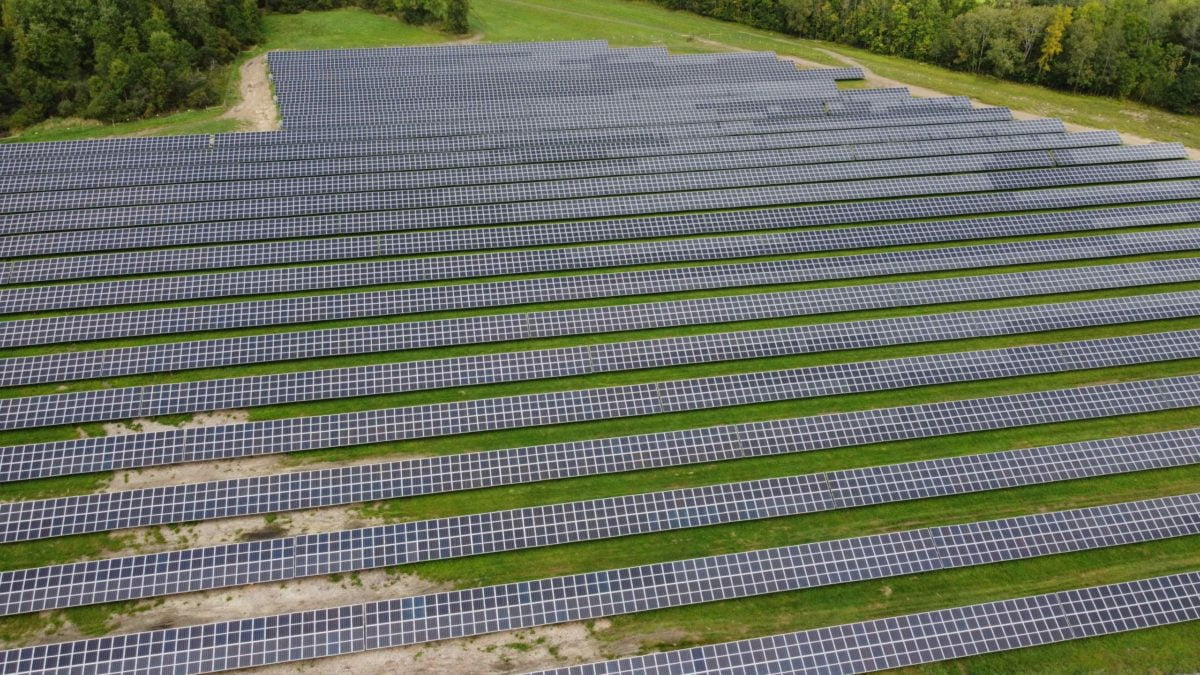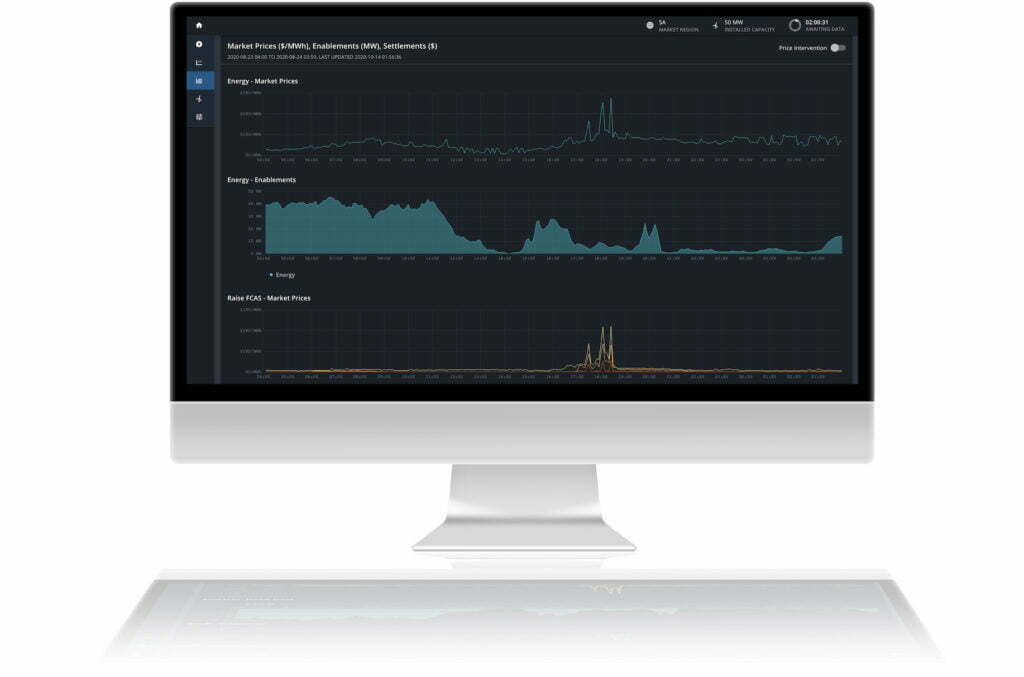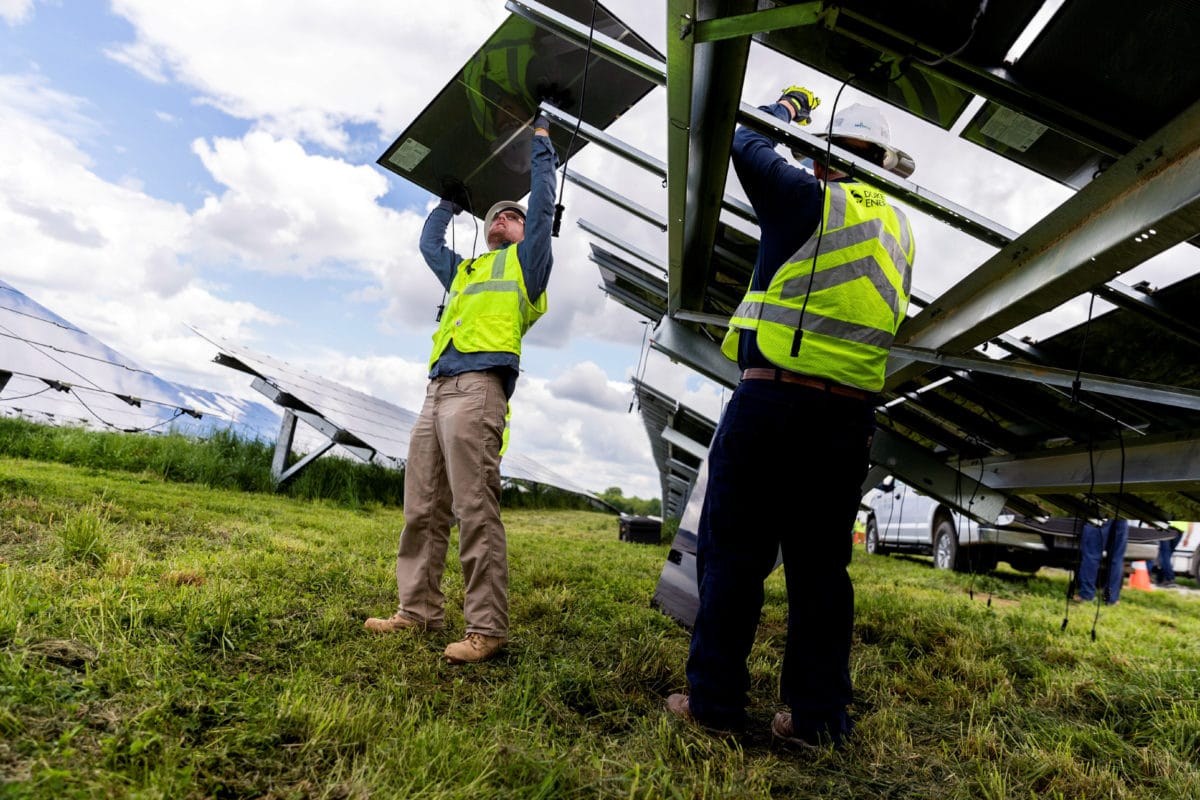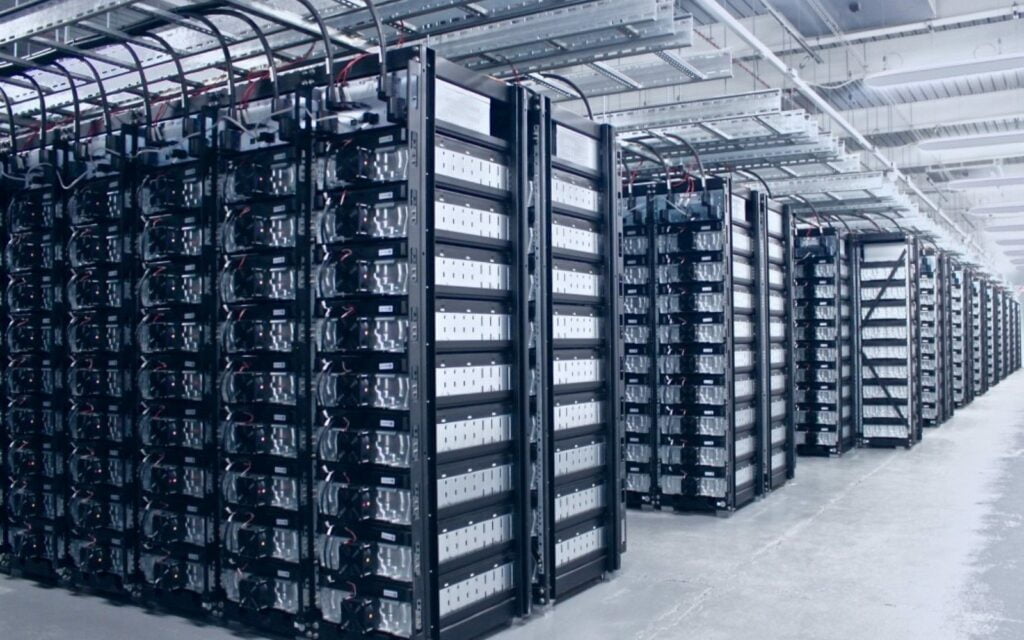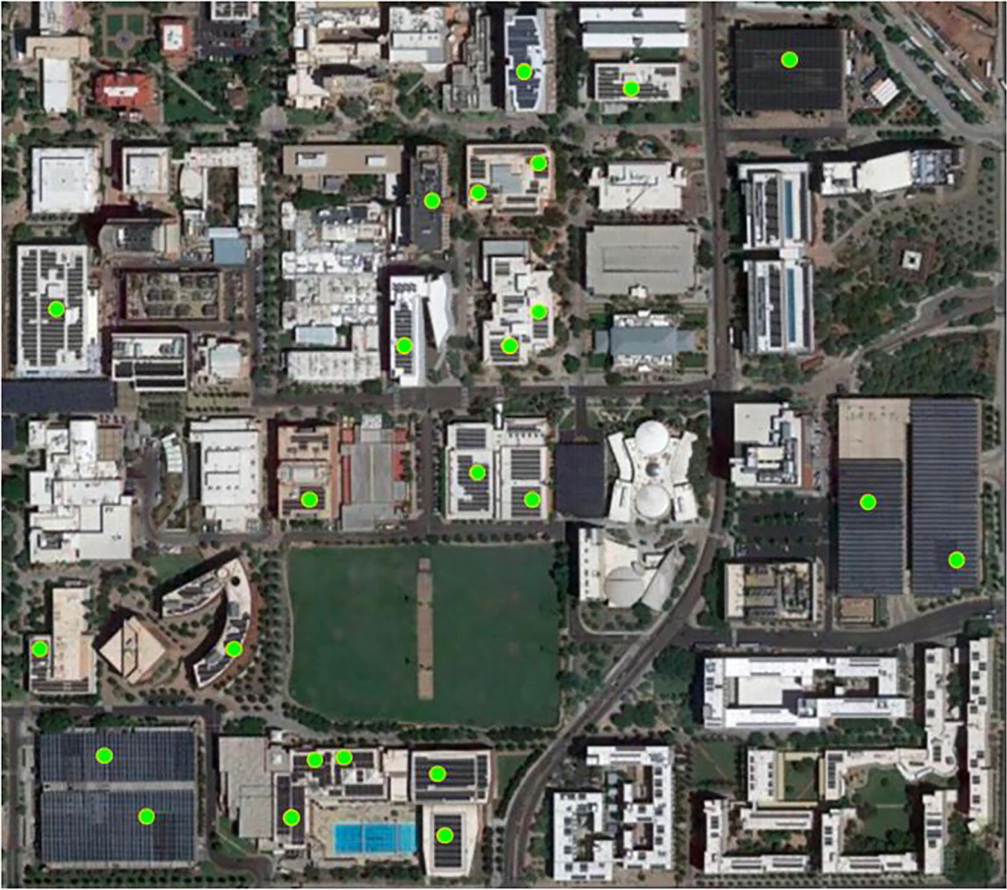“We’ve worked in partnership with NREL on our in-house developed world-beating low-cost reflector system for close to a decade,” said John King, CEO and cofounder of Hyperlight Energy.Hylux differs from conventional CSP design in that it uses recyclable plastic as opposed to the large quantities of steel normally used to construct CSP plants. Constructing with steel presents several challenges including cost of materials and transportation, supply chain issues, etc. With plastic, Hylux can be installed on-location and designed to fit a range of industrial settings.“The new technology from NREL offers a breakthrough in design methodology that optimizes optical capture, with no additional cost for the hardware,” said Guangdong Zhu, inventor and senior engineer at NREL. “Up until now, the receiver design process started with an equation followed by a ‘guess-and-check’ approach through optical modeling of multiple iterations of the curve. However, the best way to do it is to use optical modeling from the start and let that tell you the optimal design with no guess work involved. You end up with the same material and production cost, but with a boost in performance for free.”Hyperlight received a $5.5 million grant from the California Energy Commission to develop a commercial solar field to provide process heat for the Saputo cheese factory in California. The project deploys Hylux to provide a portion of the heat necessary in Saputo’s cheese-making processes via a 1.5-acre solar array. The company also has an MOU for a thermal enhanced oil recovery (EOR) project to decarbonize the transportation supply chain as well as multiple additional projects in the pipeline.The title was amended on Feb. 3, 2022 to remove mention of receiver design replacing steel with plastic. The receiver itself is still made with the same materials.
Continue readingKey cybersecurity considerations for renewable energy plant operators in 2022
As global markets transition toward more renewable energy sources, cyber hackers will look for ways to exploit those resources. Cybersecurity is now a business imperative. February 2, 2022 Kyle TobiasIn recent years, the power industry has become more connected than ever, with a delicate grid supporting much of our critical infrastructure. Any disruption could be catastrophic, highlighting the need for organizations to proactively protect their assets from pressing risks, including the surge in cyber attacks. The addition of solar and other renewable energy plants has only heightened these vulnerabilities, as these assets are targets for attackers.As a result, the North American Electric Reliability Corporation (NERC)’s Critical Infrastructure Protection (CIP) standards now include cybersecurity requirements with hefty consequences for violations. This has made compliance top of mind for chief information security officers (CISOs) and their teams, but implementing good cyber hygiene requires more than baseline compliance—it requires an investment into an industrial cybersecurity program that grants you full visibility and control over your operational technology (OT).NERC CIP Standards: Cybersecurity is Here to StayThe old adage “spend a dollar today to save a hundred tomorrow” rings true for compliance. In 2021, NERC CIP enforcement charged 37 compliance penalties totaling $16,786,000, an average of $453,676 per violation. As significant as these fines are, most power producers understand that these penalties can incur even higher costs.Kyle TobiasRegulations are constantly being updated, and now include cybersecurity controls. What was once only required of medium or high-risk groups is now commonplace at low-risk levels. To best prepare themselves for imminent regulatory standards and inevitable cyber attacks, organizations should not wait for regulations to dictate what cybersecurity looks like at their facilities; the probability of it being more expensive in the long run (through penalties or attackers exploiting regulation gaps) is high. It leaves fleet owners in a position of constantly playing catch-up; an unnecessary burden as regulations are clearly moving in a direction that requires strong cybersecurity measures.Staying ahead of requirements also allows organizations to implement controls at a manageable pace, proactively keeping costs down and enabling managers to spend more time assessing and addressing risk.Moving Beyond Compliance: Adopting Cybersecurity Best PracticesBefore adopting an OT cybersecurity program, it is important to understand the difference between compliance and best practices. Although they can seem interchangeable, internal teams and Managed Security Service Providers (MSSP) should understand that a cyber risk management program will go beyond compliance to truly manage, monitor, detect and defend an organization against growing cyber threats.Compliance is a minimum set of rules or actions that a team must follow to conform to a policy or standard. However, best practices establish actual methods and techniques that leadership will adapt to because they are superior to any alternatives, proven by their results. Furthermore, best practices are built into an organization as a standard way of operating.Knowledge is Power: Educating Your Organization from the Top DownEducation about cybersecurity best practices, including procedures, processes and the use of technology solutions, must be consistent at all levels, from the CISO to site operators. Power generation CISOs (or those responsible for compliance within an organization), are beginning to understand the importance of industrial cybersecurity—especially with the rise of cyber attacks and the outward threat against the US power grid from foreign adversaries. Furthermore, boards of directors are becoming actively involved in cybersecurity as it now affects the bottom line.At a more granular level, operators are now being instructed to complete system inventories, including both hardware and software to determine the criticality of these systems. Knowing which systems to protect allows plant operators and managers the ability to prioritize their budget and focus on protecting their most critical assets first. This knowledge empowers and assists CISOs in making cybersecurity a priority and ultimately implementing a strong industrial cybersecurity program to manage cyber risk in the most cost-effective way.Don’t Fall Behind: The Cybersecurity CurveIt is no longer a question of if your plant will experience a cyber incident, but when. The next step for industrial companies is to proactively prevent operational disruptions that could impact critical infrastructure. As global markets transition toward more renewable energy sources, cyber hackers will look for ways to exploit those resources. This makes cybersecurity a business imperative.Hackers are aware of and will turn their attention to the increasing number of new generation and transmission projects being proposed. Don’t join the list of organizations that fall behind the curve and can’t address vulnerabilities until it’s too late.When it comes to mitigating cyber risk, what end of that spectrum do you find your facility on? If your organization needs to move beyond compliance, it’s best to start from the top to implement change and reduce the overall likelihood of cybersecurity gaps that could prove costly to an organization.Kyle Tobias is a senior cybersecurity assessor with ABS Group. He has over 18 years of OT cybersecurity experience in planning, operations, training and audits in the maritime, energy, banking, finance and telecommunications industries, and has successfully achieved client goals across the globe. Kyle holds a BA from Olgethorpe University and a MS in Cybersecurity from the Georgia Institute of Technology.The views and opinions expressed in this article are the author’s own, and do not necessarily reflect those held by pv magazine.This content is protected by copyright and may not be reused. If you want to cooperate with us and would like to reuse some of our content, please contact: editors@pv-magazine.com.
Continue readingDSD Renewables acquires 45MW of Massachusetts community solar and storage
The 45MW of solar and 88MWh of battery energy storage will operate under Massachusetts’ SMART and Low Income Community Shared Solar programs, providing electricity bill credits to low-income subscribers February 2, 2022 Tim Sylvia
Continue readingFord, Sunrun to backup solar homes with the electric F-150
With Ford Intelligent Backup Power and the Home Integration System, F-150 Lightning will automatically kick in to power the home if the grid goes down, while also giving customers the freedom to charge their truck or power their home using their residential solar installation. February 2, 2022 Tim SylviaWhen the the all-electric Ford F-150 Lightning pickup truck hits the road later this spring, it will deliver the same utility that has made the F-150 line a leader among all truck offerings. However the Lightning will be able to deliver something that no pickup truck has done before: it can power your home.Ford has teamed up with Sunrun to enhance home energy management, leveraging the substantial onboard battery capability of the Lightning with Ford Intelligent Backup Power, to give customers the ability to use bidirectional power technology from their all-electric truck to provide energy to their homes during an outage, or to reduce their reliance on the grid when electricity prices are high.With Ford Intelligent Backup Power and the Home Integration System, developed in collaboration with Sunrun, F-150 Lightning automatically kicks in to power the home if the grid goes down. The Home Integration System and Ford Charge Station Pro, the truck’s charging unit, are composed of a power inverter plus a dark start battery and transfer switch, enabling the two-way power flow. Buyers of the extended-range F-150 Lightning automatically receive the Ford Charge Station Pro, while standard-range truck customers can purchase the 80-amp Ford Charge Station Pro and pay for activation separately.The Home Integration System and Ford Charge Station Pro are designed in what is called a vehicle-to-grid direct current configuration (V2G-DC). In V2G-DC, power conversion and smart functions are housed in the electric vehicle supply equipment (EVSE), where the EVSE essentially works like a stationary smart inverter offering grid-support benefits and communication functions to asset operators, in addition to converting power.The Lightning’s extended-range battery system can store up to 131kWh of electricity and deliver up to 9.6kW. For comparison, a Tesla Powerwall 2, one of the leading home storage solutions can store up to 14kWh of electricity and deliver up to 5kW continuously, with a max peak of 7kW.As a battery alone, the Lightning has a storage capacity equivalent to roughly 9.4 Tesla Powerwall 2 units. Ten batteries would cost approximately $5,500 each before installation costs, while the Lightning is available at a price that can range from $39,974 to upwards of $95,000, depending on which available options the customer chooses. Plus, you can’t drive a home battery to work.Once power is restored, the system automatically reverts back to utility power, but users can configure the system to charge their truck using their residential solar installation, if they so choose. Based on an average U.S. home at 30 kilowatt-hours of use per day, F-150 Lightning with extended-range battery provides full home power for up to three days, or as long as 10 days when used in conjunction with solar power or considerable energy usage rationing.Outside of the development assistance with the Home Integration System Ford and Sunrun are partnering to provide a seamless installation solution with Sunrun employees installing the specific charging hardware. As part of the partnership, Ford shares that customers interested in combining Ford Charge Station Pro installation with solar power may be eligible to do so for zero dollars down and reduced installation pricing.This content is protected by copyright and may not be reused. If you want to cooperate with us and would like to reuse some of our content, please contact: editors@pv-magazine.com.
Continue readingDistributed solar and storage owners face one more hurdle before participating in wholesale markets
“Relatively minor” changes are needed in distribution planning and operations before owners of distributed solar and distributed storage may earn money from participating in wholesale markets through an aggregator, says a report from the Energy Systems Integration Group. February 2, 2022 William DriscollSunrun, Tesla, and Stem backed an early proposal by the Federal Energy Regulatory Commission (FERC) to require grid operators to open their wholesale markets to participation by distributed solar and distributed storage, as well as other distributed energy resources (DERs). That proposal, which called for an aggregator serving as intermediary between DERs and grid operators, became FERC Order 2222.As grid operators, known as RTOs and ISOs, comply with the order, one more step remains before distributed solar and storage can sell energy, capacity, and ancillary services into wholesale markets, says an Energy Systems Integration Group (ESIG) report.That step involves “relatively minor” near-term changes in distribution system planning and operations, and only minimal infrastructure investments. Those changes will require involvement of both state regulatory commissions and distribution utilities, the report says, many of which “are still in the early stages” of such work.“For those utilities that had not planned for DER coordination in operations and markets, FERC Order 2222 compliance can be challenging. This report provides a path forward,” said Debra Lew, associate director of ESIG.The report outlines minor, “no regrets” changes relating to DER interconnection processes, DER aggregation review, a way to communicate distribution system problems to aggregators, and a fair process for overriding RTO/ISO dispatch of DERs. To help with the last item, the report recommends adoption of the IEEE 1547-2018 standard for smart inverters, which “may reduce the need for overrides and distribution upgrades.”MotivationA possible motivator for action by states and distribution utilities would be the lower costs and lower greenhouse gas emissions that ESIG projects from DER participation in wholesale markets.The report explains the cost-saving efficiencies: “when the transmission system has excess supply, distribution systems can increase demand by shifting load, reducing generation, or charging storage. Conversely, when the transmission system is short of supply, distribution systems can reduce demand by shifting load, increasing distributed generation, or discharging storage.”Once the “no regrets” steps are taken, the report outlines further steps needed in “the transition to future distribution systems,” saying that as DER uptake continues, distribution and transmission systems will need to be “increasingly planned” as an integrated system, and their operation more closely coordinated.Alternate pathwaysESIG’s report says that direct participation by DER aggregators in wholesale markets, a path initiated by FERC Order 2222, is “one of several pathways”—or structural participation models—to integrating DERs into wholesale markets. The report notes that the California ISO’s Distributed Energy Resource Provider model, approved by FERC in 2016, and “in many ways a model for Order 2222,” has had no users to date.“Regardless of Order 2222’s direct impact,” the report says, “FERC has triggered a national conversation.” Many DER market and system integration issues that will arise in higher-DER futures “do not lend themselves to quick solutions, but it is important to begin exploring possible solutions now to lay the groundwork for longer-term change.”ESIG is developing a related report that envisions an “open network initiative” in the United States, akin to initiatives in Australia and the United Kingdom, that “could provide a forum for dialogue on the most critical of these issues.”ESIG is a professional association that charts the future of grid transformation and energy systems integration, particularly with respect to clean energy. The ESIG report, titled “DER Integration into Wholesale Markets and Operations,” is accompanied by a fact sheet and a slide show.The title of this article was changed on Feb. 2 to specify that it is about distributed solar and distributed storage, not solar-plus-storage as written previously.This content is protected by copyright and may not be reused. If you want to cooperate with us and would like to reuse some of our content, please contact: editors@pv-magazine.com.
Continue readingFluence continues diversification with renewables market software firm partnership
Fluence has boosted its digital capabilities further with the Pexapark partnership. Image: Fluence.
Energy storage specialist Fluence and renewable energy market software and advisory firm Pexapark have entered into a long-term strategic partnership, confirming Fluence’s accelerated push into wider renewable energy and energy storage software services.
The partnership gives Fluence’s customers access to Pexapark’s suite of analytical tools and services through the Fluence IQ digital ecosystem. These include market intelligence about renewable energy power purchase agreements (PPAs) and energy portfolio risk management optimisation solutions.
For Pexapark, combining with Fluence’s fleet of 3.6 GW of battery-based energy storage solutions will accelerate the incorporation of energy storage analytics into its software products, which are currently majority-focused on wind and solar. Pexapark says it has supported more than 20 GW of renewable power purchase agreement (PPA) transactions to-date.
As previously discussed on Energy-Storage.news, software is fast becoming a key differentiator for energy storage technology companies. Big growth in energy storage and renewables and increased volatility and regulatory changes are making data-driven market intelligence a must-have for electricity market participants, the companies say.
Software platforms can connect energy assets to energy markets by enabling optimisation and real-time bidding, which helps drive digitisation in the market.
In line with the trend, Fluence acquired energy storage software and AI pioneer Advanced Microgrid Solutions (AMS) in October 2020 and re-branded its offerings as Fluence Digital and Trading Platform. Fluence partnered with AMS to provide additional market functionality to its customers for over a year before acquiring AMS outright. Six months later it had its first customer in a 730MWh Lithium-ion battery storage plant in California.
AMS’ CEO-turned-Fluence chief digital officer Syed Madaeni has claimed that acquisition will help increase return on investment on energy storage assets from 10% to 30% for Fluence customers, albeit specifically in AMS’ Australian and US markets.
Longer-standing players in the renewable space have launched similar market intelligence products. Tesla has ‘Autobidder’ while Finnish group Wärtsilä, a rival to both Tesla and Fluence, has ‘Intellibidder’.
Fluence was founded as a JV between Siemens and AES in 2018 and IPOed on the NASDAQ late last year at a valuation of US$4.7bn.
In somewhat related news, our sister site PV Tech reported today that smart AI-driven energy storage provider Stem Inc’s acquistion of solar asset management platform and services company AlsoEnergy has closed.
Continue readingRFP Alert: Mississippi Power seeks 200MW of solar
Project proposals must be at least 20MW of solar tied to a 25-year power purchase agreement. February 2, 2022 Ryan KennedyUtility Mississippi Power announced a request for proposal (RFP) for a total of 200MW of solar photovoltaic projects. The projects must have an export capability of the point of interconnection of at least 20MWac. The RFP states that the utility accepts only proposals that include 25-year energy-only power purchase agreements, and the projects must be in the state of Mississippi. Applications are due March 15, 2022. Mississippi Power said after evaluating the proposals the final bid list is planned to be accepted August 1, 2022, and interconnection requests are due within five days of notification of an accepted bid. There is a bid evaluation fee for the RFP of $5,000, which is fully non-refundable. The full RFP document, which includes terms for environmental attributes, curtailments, delivery requirements, interconnection, and more, can be viewed here.Solar activity in MississippiMississippi Power joins another utility in the state, Entergy, in planning to add more solar PV to its energy mix. Entergy’s plan calls for 1GW of solar and other renewables in five years. The additions would bring solar from 1% to 33% of the utility’s capacity share by 2027. The company said it would begin issuing RFPs this year, replacing natural gas infrastructure with solar to serve its growing base of over 450,000 customers.Mississippi’s solar capacity is set to multiply as major project proposals are accepted across the state. Like many of the states in the US Southeast, a combination of large-scale corporate solar contracts and utility-scale projects like the ones called for in the above RFPs. The Solar Energy Industries Association estimates about 319MW cumulative solar capacity in the state through 2021, a number that will be trounced by the completion of these RFPs alone. Plus, rooftop solar is set to get a boost as the state recently decided on a new incentive that provides a one-time upfront rebate of $3,000 for a new system between 3kW and 6kW. The state’s net metering rate is quite low at $0.025/kWh, but the commission did add a new $0.02/kWh adder for customers who are at or below 250% of the federal poverty line.This content is protected by copyright and may not be reused. If you want to cooperate with us and would like to reuse some of our content, please contact: editors@pv-magazine.com.
Continue readingA battery is only as good as its control system
A possible failed bearing and a software programming error in a heat suppression system caused a cascading incident that damaged 7% of Vistra Corp.’s Moss Landing Energy Storage Facility. February 2, 2022 John Fitzgerald WeaverThe world’s largest lithium ion battery, the Moss Landing Energy Storage Facility, was shut down due to a cascading series of unfortunate events, which may have resulted from a failed fan bearing giving off smoke, per the company’s release:At approximately 6:41p.m. on Sept. 4, smoke was detected by VESDA units in the vicinity of cores 64, 57, 47 and 41, causing water to be released to preaction zone 24 and stopping the flow of electrical current through the affected cores (an automated process referred to as E-Stop). Due to an apparent programming error in the VESDA, these actions occurred at detected smoke levels below the specified design level at which water was intended to be released and E-Stop was intended to be initiated.The very early smoke detection apparatus’ (VESDA) notification set off a water release action. This action caused a water-based battery heat suppression system to activate. Unfortunately, when the couplings on flexible hoses of this system failed, water sprayed directly onto additional battery racks, causing short circuiting and arcing, which damaged the batteries and made more smoke. The additional smoke set off more alarms and caused even more water to spray from the failed couplings.LG Energy — rack level fire suppression systemLGVistra notes that during the construction process, there was some pressure testing that occurred, for instance the preaction header piping and the piping on each battery rack underwent separate pressure testing. However, Vistra has been unable to confirm that the contractor pressure tested the complete heat suppression system after the racks were connected to the header pipes.In the end, 7% of the facility’s batteries were damaged by water, along with other infrastructure. Notably, there was no temperature increase noted in any battery modules at any time during the incident.There are two battery facilities owned by Vistra on the site. The smaller, and newer, 100MW/400 MW facility was not affected. The original, larger, 300MW/1.2 GWh structure was where the incident occurred.The 300MW facility is broken down into three 100MW arrays, with 98 cores, and 4,539 racks, holding 99,858 modules of batteries. Each battery module, part number M48290P5B (4P) on the LG Energy website, is housed within the new TR-1300 double wide form factor. LG’s JH4 battery cell populates these units.Each module holds 14.9 kWh of 72.5 Ah JH4 cells, while the just over 5,000 pound TR1300 holds 327 kWh of energy.A video released by LG Energy showcasing the TR 1300 briefly highlights the fire suppression system (starting at 2 minutes and 46 seconds.)The fire suppression system includes a standard water sprinkler system. A separate water-based heat suppression system that is specifically designed to protect against thermal runaway in individual battery modules is also deployed. This system has carbon steel header pipes that are connected by flexible hoses to piping on each rack.This content is protected by copyright and may not be reused. If you want to cooperate with us and would like to reuse some of our content, please contact: editors@pv-magazine.com.
Continue readingUK investor confidence in battery storage grows, as industry does too
Inside the Bloxwich battery storage plant in the UK. Image: Arenko.
As you may know, in addition to the international sites Energy-Storage.news and PV Tech, our publisher Solar Media has two UK-focused clean energy news websites, Current± (which covers broad energy transition topics) and Solar Power Portal (which covers solar PV).
Across the two sites, deputy editor Molly Lempriere and Alice Grundy bring readers the top UK energy storage news and views and this week we have a bit of an anthology of recent stories for you here.
Battery storage is ‘standing on its own two feet’ as investor confidence rises
31 January 2022
Investors are now becoming more comfortable with battery storage in the UK, with projects being profitable and cost-effective, according to industry experts.
Speaking at the Annual Marketplace event hosted last week by trade group Electricity Storage Network, Alicja Kowalewska-Montfot, commercial manager-energy storage at Gore Street Capital, said the asset owner had established a “very strong” retail base of investors, who would typically be more risk averse to newer technologies and that are now getting comfortable with this sort of asset class.
This in turn is showing that investors are getting more comfortable with the associated merchant risk and understand that in the absence of long-term or government-backed contracts, “they are indeed capable of functioning in the context of the fundamentals that are happening in the market, so the growth of renewables”.
She added that what is “incredible” about battery storage is that it never had a subsidy.
“This to me is one of those very interesting stories of a technology that effectively proved to be capable of being merchant and unsubsidised pretty much from day one,” Kowalewska-Montfot said.
Indeed, Ben Guest, managing director and head of another major UK asset owner, Gresham House New Energy, said: “It’s a cost-effective technology, and a reliable technology which is resulting in profitable, unsubsidised projects so clearly it’s an area that’s standing on its own two feet.”
Guest went on to detail Gresham House’s revenue model, which he said is focused on three accessible layers, these being trading, frequency response and Capacity Market revenues. He said the Capacity Market revenues are available to every battery, and will be 5-10% depending on the size of the battery and the revenues it is expected to make elsewhere.
Guest added that Gresham has always said from the outset that the ancillary services market including frequency response was going to saturate as it’s naturally a shallower market, while the deepest part of the market is trading.
He said that with the high levels of wind and solar expected on the energy system as the UK decarbonises, and the intermittency of that, storage will be needed and there will therefore be big trading opportunities.
By Alice Grundy
To read the full version of this story visit Current±.
Arenko to optimise a further 455MW of Gresham House battery storage in extended partnership
1 February 2022
Clean energy asset automation and optimisation company Arenko Arenko has been awarded contracts to optimise a further 455MW of Gresham House Energy Storage Fund’s battery storage assets in an expansion of the pair’s multi-year relationship.
Having been working together since 2020, Arenko has now been awarded contracts to carry out asset optimisation on an additional five utility-scale battery storage assets for Gresham House. Totalling 210MW, the contracts are expected to come into force during this year.
An additional framework agreement has also been signed to optimise a further 215MW, while Gresham House has renewed the Byers Brae contract, which Arenko has been optimising since March 2021.
These new agreements mean that Arenko has been awarded contracts for the asset optimisation of over 500MW of Gresham House’s energy storage portfolio in total.
Under the agreements, Arenko will use its end-to-end trade optimisation and automated dispatch software to maximise returns from the battery storage assets.
By Alice Grundy
To read the full version of this story visit Current±.
SMS energises its first 50MW battery energy storage site in 620MW pipeline
31 January 2022
UK smart energy tech company SMS has energised its first battery energy storage system (BESS), the 50MW Burwell site in Cambridgeshire, east England.
The lithium-ion BESS will now deliver a range of balancing and ancillary services to National Grid ESO, providing flexibility for the grid. SMS announced the start of construction of Burwell in February 2021, with the project originally expected to be completed in the final quarter of 2021.
It is the first of a pipeline of 620MW of BESS projects either under construction or being planned by SMS, with a second site – a 40MW system in Barnsley, Yorkshire – also nearing completion. Following on the heels of these sites, are two more 50MW sites in Suffolk and Derbyshire.
SMS’s 620MW portfolio includes 140MW of assets already under construction and 100MW that has been fully secured, while the remaining 330MW is under exclusivity. It is planning to complete this pipeline of projects by 2025.
Established in 1995, SMS is best known for its role in the national rollout of smart meters, where it provides funding, installation, operation and management of smart meters and carbon reduction assets.
By Molly Lempriere
To read the full version of this story visit Current±.
SMS’ Burwell 50MW BESS site. Image: SMS.
RES submits application of 100MW Spennymoor battery energy storage project
1 February 2022
Renewable asset developer RES has submitted a planning application for a 99.9MW battery energy storage project in County Durham, northeast England.
The Spennymoor site forms part of the company’s portfolio of over 700MW of energy storage projects in development or construction in the UK and Ireland currently.
If approved it would sit adjacent to the Spennymoor substation, and provide grid balancing services. It has already gone through several design iterations in response to site surveys, with the version submitted including a number of biodiversity measures.
“As we make the rapid transition to low-cost renewables it’s important that we develop more energy storage capacity on our grid to support a more flexible system,” said Jenna Folkard, RES development project manager.
To date, RES has developed 23 energy storage projects globally and has delivered more than 22GW of renewable energy projects, including onshore and offshore wind, solar, energy storage, transmission and distribution, over its 40-year history.
By Molly Lempriere
To read the full version of this story visit Solar Power Portal.
This is just a small sample of the great UK-focused clean energy content, including energy storage and solar, you will find over at Current± and Solar Power Portal. Subscribe to their newsletters for regular updates.
Continue readingAppeals court ruling could bring Phoenix solar market back to life
A U.S. district court must rule on federal antitrust claims made by four plaintiffs against Arizona utility SRP’s anti-solar rate, and must consider “injunctive relief” that could immediately halt the anti-solar rate. February 2, 2022 William DriscollFour customers suing Arizona utility Salt River Project (SRP) over its anti-solar rate “adequately allege antitrust injury,” said the U.S. Ninth Circuit Court of Appeals in a ruling on Monday. Now the U.S. district court that had originally dismissed the lawsuit must take up the case anew, which could result in an end to the anti-solar rate.Halting the anti-solar rate could revive the rooftop solar market in the Phoenix area, where SRP serves about one million households.Four SRP customers with rooftop solar had sued the utility in federal district court after their bills went up an average of $600 a year, which they claimed unlawfully discriminated against customers who added rooftop solar. When the district court dismissed the case, the four plaintiffs appealed.“Applications for solar-energy systems in SRP territory decreased by between 50 and 96 percent” after the anti-solar rate went into effect in 2015, the appeals court noted.If the district court grants injunctive relief on the plaintiffs’ federal antitrust claims, that could mean halting the discriminatory rate structure immediately, “which could have the effect of allowing rooftop solar to flourish in SRP territory,” said Jean Su, an attorney and director of the Center for Biological Diversity’s Energy Justice Program. The Center had filed a “friend of the court” brief in the case along with four other groups.Because SRP was established as an agricultural improvement district and is thus a subdivision of the state, the appeals court ruled that SRP is exempt from damage claims under antitrust law.The appeals court’s antitrust ruling hinges on two factors specific to SRP and Arizona. First, SRP does not file its rates with a regulatory agency for approval, so the “filed rate doctrine” that “prohibits individuals from asserting civil antitrust challenges to an entity’s agency-approved rates,” did not apply, the court said.Second, Arizona law promotes competition in the retail electricity market, the appeals court found. If Arizona law instead aimed to displace such competition, the court said that SRP, as a political subdivision of the State of Arizona, could be entitled to “state-action immunity.”Su explained that although anti-solar rates that gain approval from state-appointed utility commissions “are largely protected from antitrust claims, under both the file-rate doctrine and state-action immunity defenses,” other public power providers like SRP “may not be able to use those defenses, particularly if the anti-solar rates contradict state policy as was the case for SRP.”The appeals court also ordered the lower court to rule on plaintiffs’ federal equal protection claims, finding that those claims were filed on a timely basis.The appeals court upheld the lower court’s dismissal of plaintiffs’ claims under state law, as it found the plaintiffs did not meet Arizona’s notice-of-claim statute.The U.S. Department of Justice had also filed a “friend of the court” brief in the case. The appeals court’s decision is available here..This content is protected by copyright and may not be reused. If you want to cooperate with us and would like to reuse some of our content, please contact: editors@pv-magazine.com.
Continue reading




